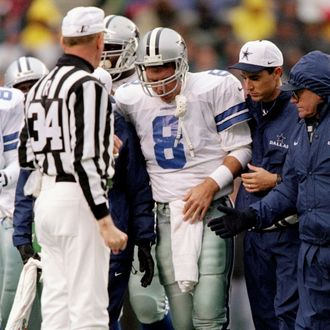
In 1994, the NFL formed the Mild Traumatic Brain Injury Committee, which in 2003 published the first of 13 peer-reviewed papers in the journal Neurosurgery that played down the danger of hard hits to the head. The committee’s chairperson said that his group sought to produce “independent” and “meticulous” research, but many have since questioned the findings in those papers, even as the NFL stood by them, saying that brain injuries don’t cause long-term harm to its players. And now the New York Times finds that the data used in that research was “deeply flawed,” because it skipped over more than 100 diagnosed concussions from the period in question, and then calculated injury rates based on those incomplete data. Even though some teams had no concussions listed for years at a time, hundreds of their games were included in the calculations, thus making injuries seem much rarer than they actually were.
The paper says that at least 10 percent of head injuries diagnosed by team doctors were not included in the study. When asked about the missing cases, league officials acknowledged to the Times that “the clubs were not required to submit their data and not every club did.” In a statement, the league said that should have been made clearer, and that the missing cases weren’t part of an attempt “to alter or suppress the rate of concussions.”
But the committee’s statements had emphasized that the data set was complete at the time of publication. “It was understood that any player with a recognized symptom of head injury, no matter how minor, should be included in the study,” one paper said. The Times reports that in confidential peer-review documents, the committee wrote that “all N.F.L. teams participated” and that “all players were therefore part of this study.”
The Times reports, however, that confidential data it has obtained contradicts those statements. The reporters found, for instance, that the Dallas Cowboys didn’t have a single concussion listed in the data. During that span, quarterback Troy Aikman alone was diagnosed with four concussions. Nor was he the only star whose injuries were left out: 49ers quarterback Steve Young had suffered at least two concussions, the latter of which occurred in a September 1999 game that was the last he’d ever play. The Times reports that most teams didn’t report all of their players’ concussions. (A Cowboys spokesperson said the team participated, and did not know why the team’s data did not appear in the studies.)
One member of the concussion committee, Dr. Joseph Waeckerle, told the Times that he was unaware of the omissions. He added, “If somebody made a human error or somebody assumed the data was absolutely correct and didn’t question it, well, we screwed up. If we found it wasn’t accurate and still used it, that’s not a screw-up; that’s a lie.”
The NFL and the committee have said the papers were vigorously reviewed and vetted, but the Times reports that “more than a dozen pages of anonymous back-and-forth between reviewers and the committee show some reviewers almost desperate to stop the papers’ publication while the authors brushed aside criticism.” Bill Barr, a neuropsychologist who once worked for the Jets and who in the past has criticized the committee’s work, told the paper that by leaving out such a significant chunk of data, “You’re not doing science here; you are putting forth some idea that you already have.”





























